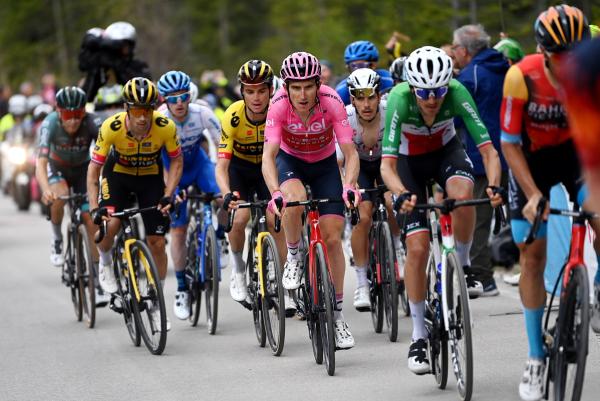Taking back control: Tour of Flanders recon with Lidl-Trek
We join the team, still reeling from their mid-week crash, to see how the riders make their final preparations for the big day
Matilda Price
Racing News Editor
© GCN
Toms Skujins is clipped in and raring to go on the recon
The morning after a long, hard race that saw three of your riders crash out and your big goals take a hefty blow, the last thing you might want to be doing is a 110km ride around the chilly, windy Belgian countryside. But this is Holy Week and the Tour of Flanders is looming, so that’s exactly what Lidl-Trek got up and did on Thursday.
We joined up with the men’s squad and their slightly depleted number for their key Flanders recon ride, to get an insight into their final preparations for Sunday’s race. The team were three riders down; Jasper Stuyven and Alex Kirsch underwent surgery on Sunday and are definitely out of Flanders, whilst a bruised Mads Pedersen escaped injury but naturally wasn’t up to the long ride on Thursday.
Though Trek haven’t yet confirmed their final line-up for Sunday, late call-ups are necessary to replace Stuyven and Kirsch. Otto Vergaerde joined the recon, pointing towards a possible start for the Belgian, while Dutchman Daan Hoole has also appeared on the provisional start list.
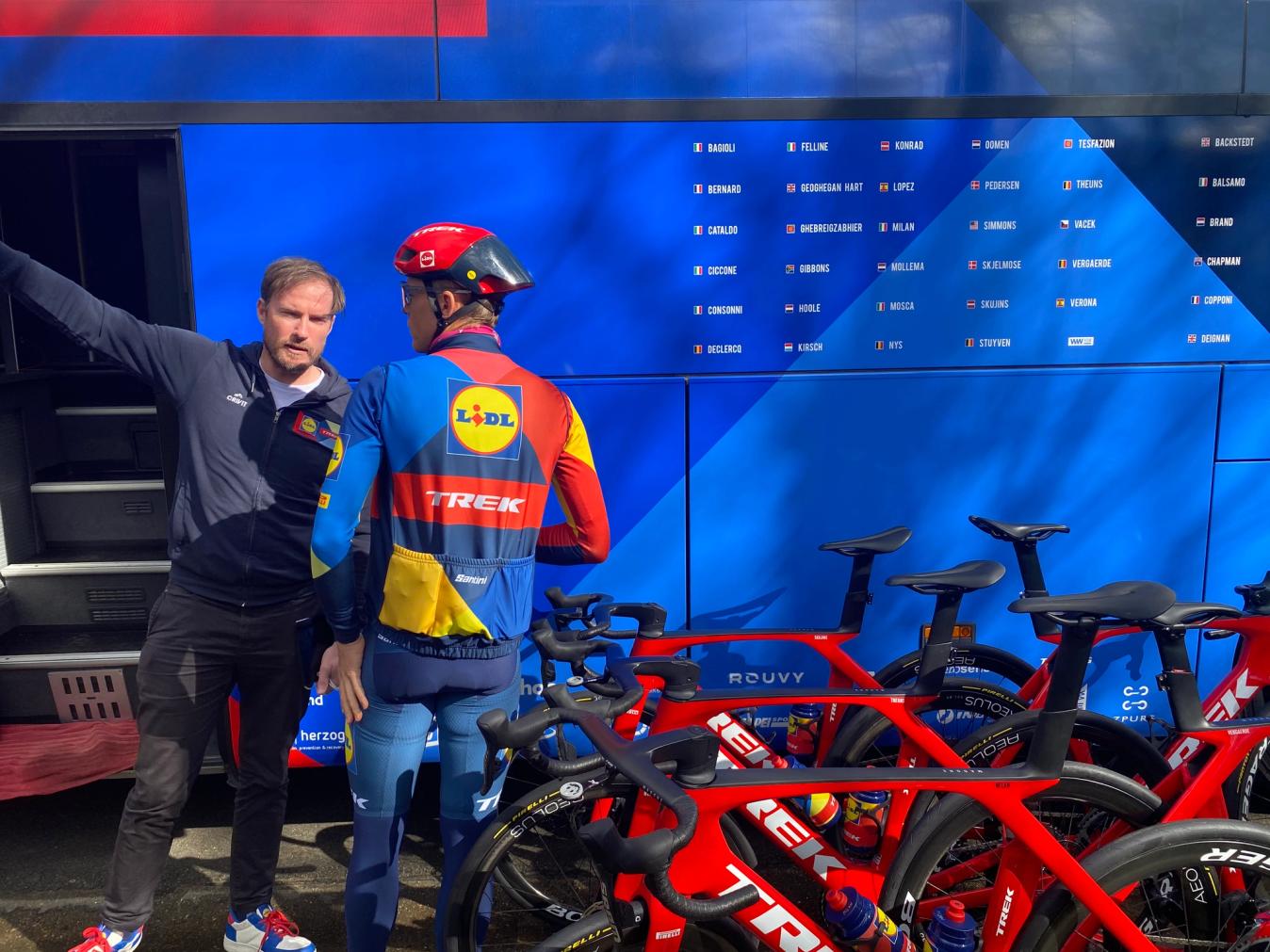
© GCN
DS Gregory Rast gives the instructions prior to the ride
Starting their recon in windy but sunny conditions, there was a relaxed, even positive, vibe around the Trek bus, despite being markedly down on their luck in the past 24 hours. Riders got ready, drank coffee, and set up their bikes.
“Did they send you our exact location or something?” a rider asks, surprised that we managed to meet them at the right nondescript layby between Ronse and Kluisbergen. Yes, yes they did – the precise coordinates, in fact. What the riders might see as just rocking up and riding is a carefully thought-out plan for the team, coaches and staff.
That said, it’s not an exact science or a particularly intense exercise. Riders will do most of the ride together, but will do more if they feel like it is what their legs – and heads – need.
“They want to do two laps. We do around 110km, some a bit less, some a bit more,” DS Gregory Rast explained to us, underlining that it’s a rider-led decision, not a regimented plan from the team.
“It will depend on the riders as to whether we do the Oude Kwaremont twice. If the riders want to do more then they’ll do it twice. We start around here and then the riders will do around three to four hours.”
- Read more: A beginner’s guide to the Tour of Flanders
Testing equipment

© GCN
Bikes are readied for the recon
As you might expect, the pace of a pre-race recon ride is not especially extreme. It’s not about doing intervals or simulating the race or bombing up the cobbled climbs. All the training, and racing, has already been done, and the physical form will be what it is on Sunday regardless of what happens on Thursday.
What is it actually for, then? In a race like Flanders, where the course doesn’t change drastically, and the riders visit a combination of the same climbs and cobbles in every Belgian race preceding it, you’d think most riders have a lay of the land.
“I am [familiar with the course] but it changes every year a little bit here and there, so you need to try and see what kind of tyre pressure you’re going to run, and just memorising every single detail is crucial,” Toms Skujiņš explained.
More so than any other race, equipment choice is key for the first of the two cobbled Monuments, and the recon can be as much about that as anything else. That much was clear on Trek’s ride, with mechanics tinkering with bikes, letting air in and out of tyres in the last few minutes before the riders set off.
Edward Theuns fiddled with his tyre pressure the most, pinching his Pirellis as he prepared to set off – for a rider as experienced as Theuns, it’s not surprising to think he can probably tell what’s right for every road in Flanders just by feel alone.
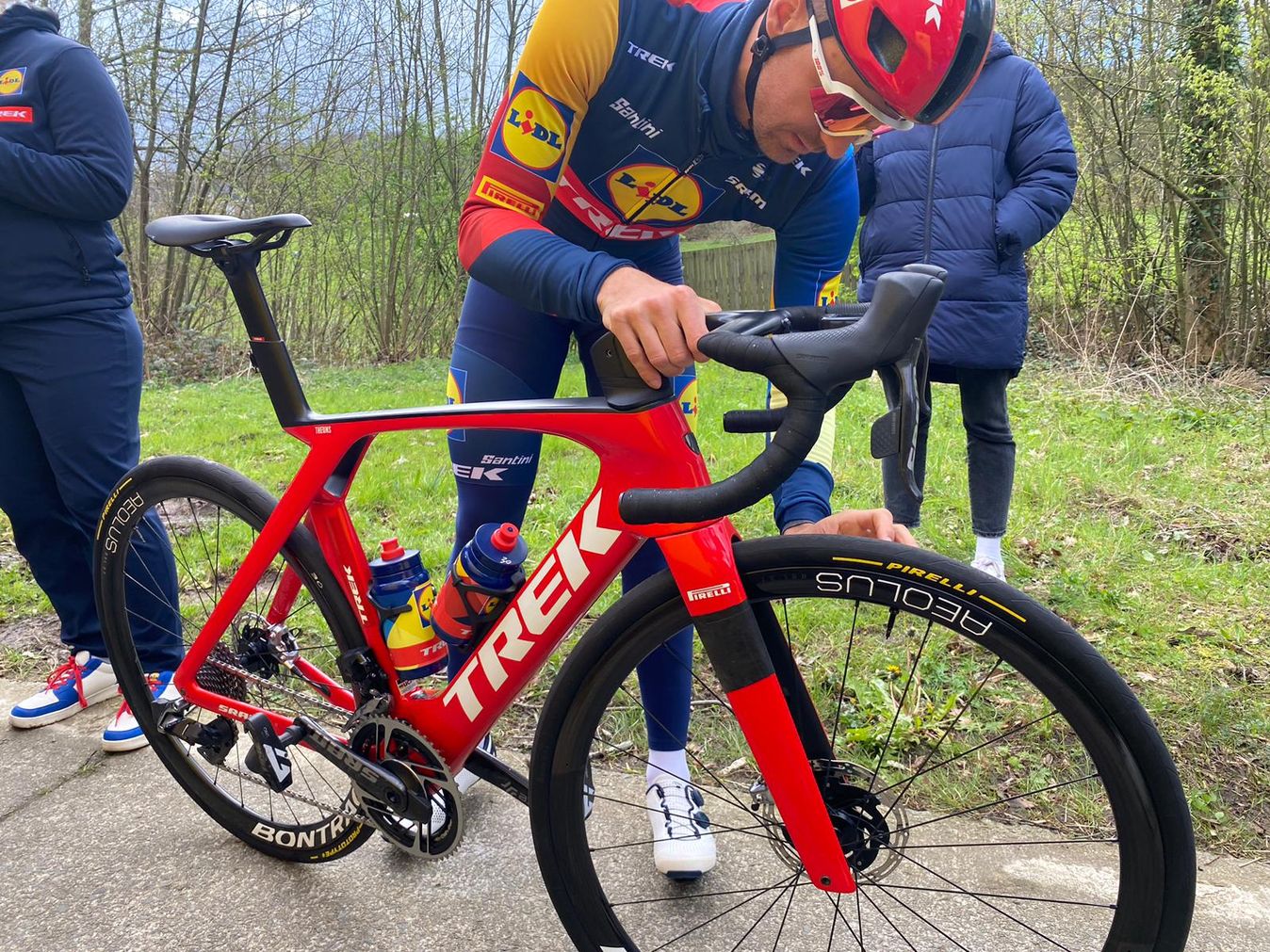
© GCN
Edward Theuns checks his tyre pressure ahead of the recon
The importance of experience
Trek’s Latvian star Skujiņš has three Flanders under his belt, and his teammates have more – six for Pedersen, eight for Tim Declercq, and no fewer than 10 for Theuns – but there’s always more to discover and learn on the twisty, labyrinthine roads of West Flanders.
“The more you ride it, the more you know, and the more years you spend racing [the better],” Skujiņš said. “That’s why a lot of the time in the Classics guys that are just more experienced, even without necessarily fitness per se, they can still be there, still be in the front, because it is so much about positioning, knowing where to move up, when to move up, and the more you do it obviously the better you can race.”
Though the race knowledge and feel may sometimes be even more important than fitness, form is obviously still important in a race as hard as Flanders, and Lidl-Trek – despite their absentees – have bags of it. Skujiņš, who may be looked at as a serious contender for the win after his performances so far this Spring, took a one-race rest to skip Gent-Wevelgem but was thrown back into it for Dwars door Vlaanderen, and has had no time to feel like he’s missing any race rhythm.
“Yesterday was hard enough,” he said. “Since Opening Weekend I’ve had every weekend away racing, except last weekend with Gent-Wevelgem, but I still raced on Friday and then Saturday and Sunday I was home. So I have enough race miles in my legs, it’s more just actually not doing too much to be honest.”
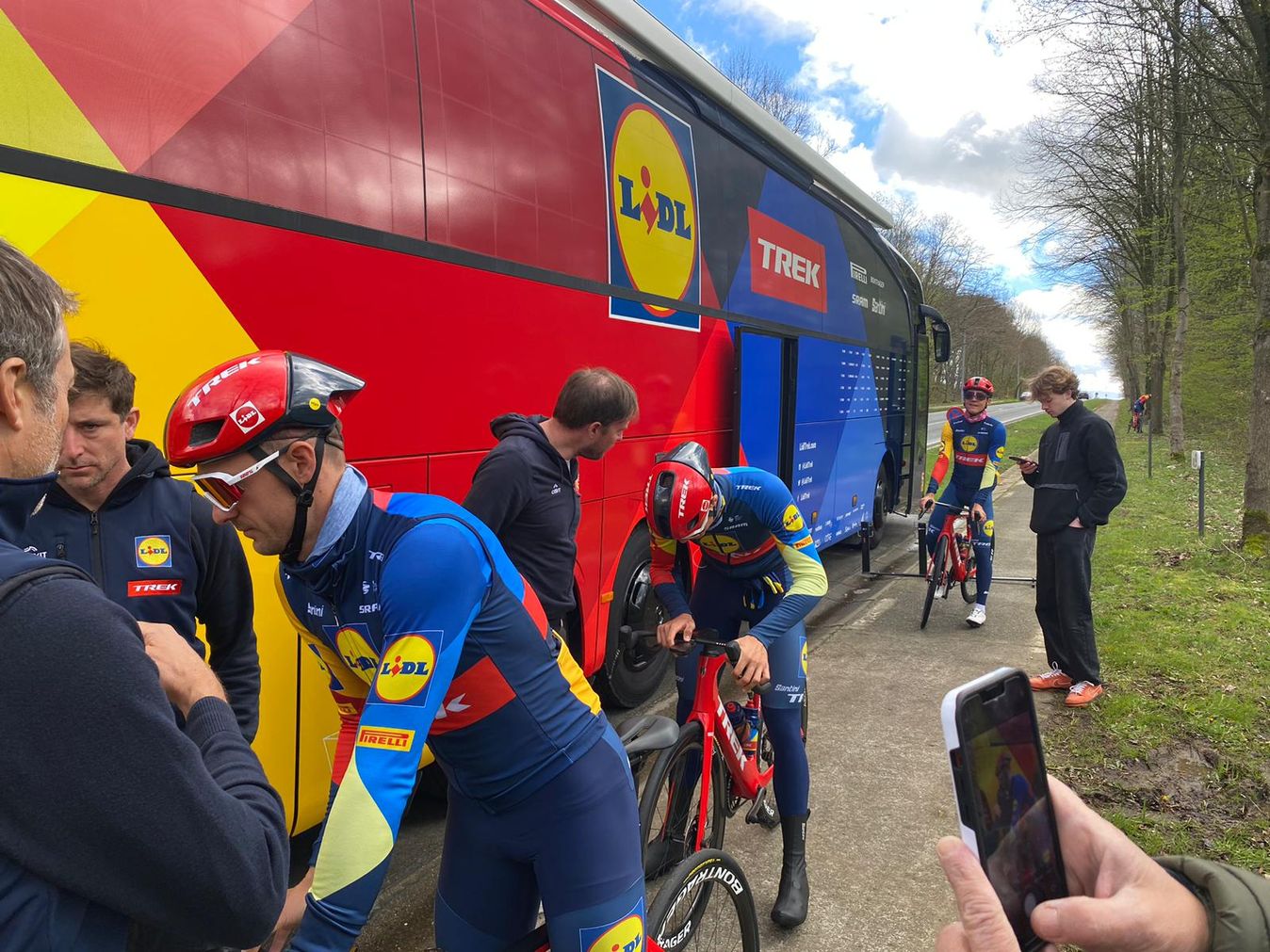
© GCN
The riders go through the pre-ride chatting and tinkering
In terms of preparation, with the recon done, there isn’t much more to do for the riders racing Flanders. Memorise those corners, keep the nerves at bay, and try to rest as much as possible.
As Lidl-Trek will be acutely aware of this week, even the best-laid plans can be ripped up in an instant, and good preparation will only get you so far. That’s even more true for a race like Flanders.
These recons, then, are a key way for teams to take back some semblance of control in the lead up to a characteristically uncontrollable race. In these final few days, recons, briefings and memorising the order of climbs and cobbles is all even the strongest teams can do.
Sunday will be hard, hectic and testing, but Thursday was the opposite of that. Riders did their own thing, chatted with each other, and regrouped after a difficult day. There’s no need for any stress, no pressure from the team car. In some ways, it was just a ride. But even so, a ride for some of the best riders in the world, targeting one of the sport’s biggest prizes.
When that’s what’s on the line, there’s no room to forget a single corner or cobble.
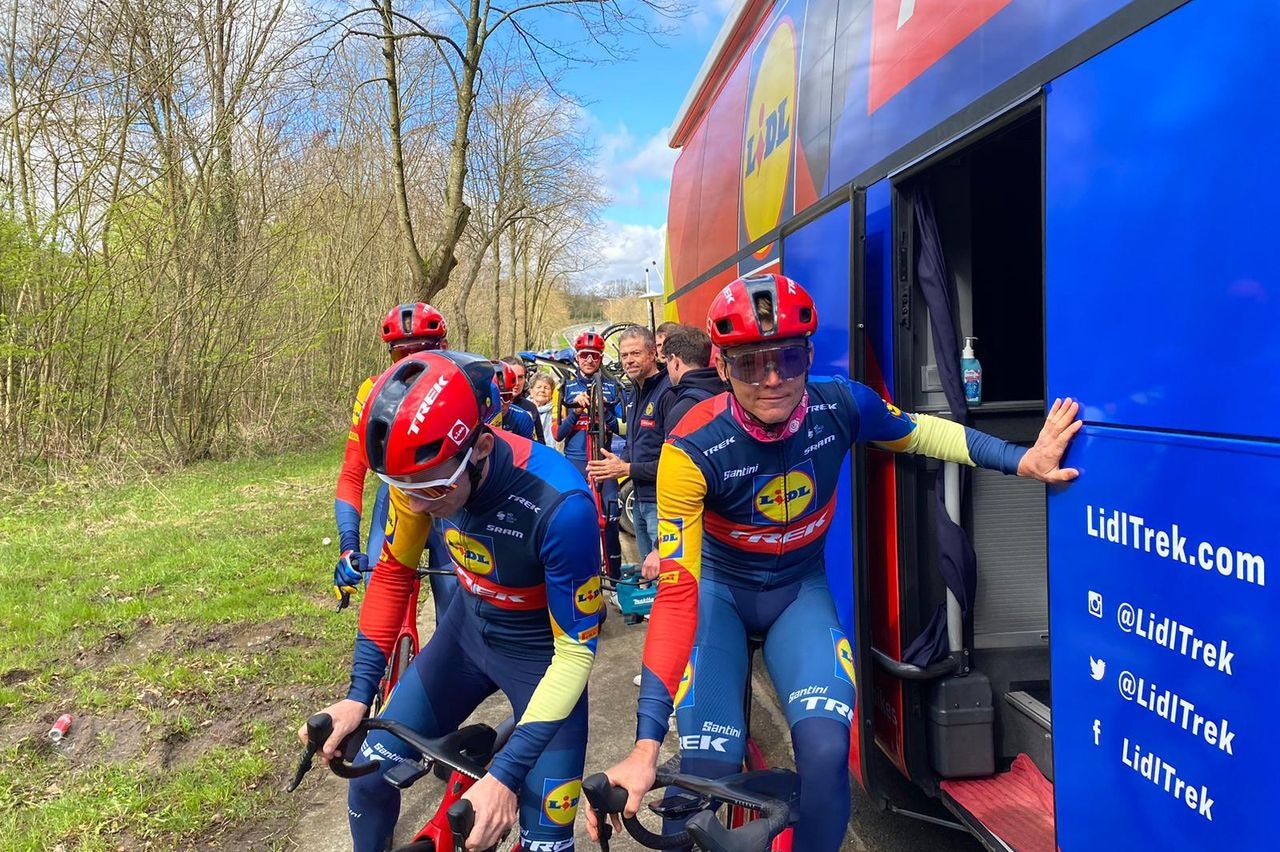




.png?w=600&auto=format)








.jpeg?w=600&auto=format)
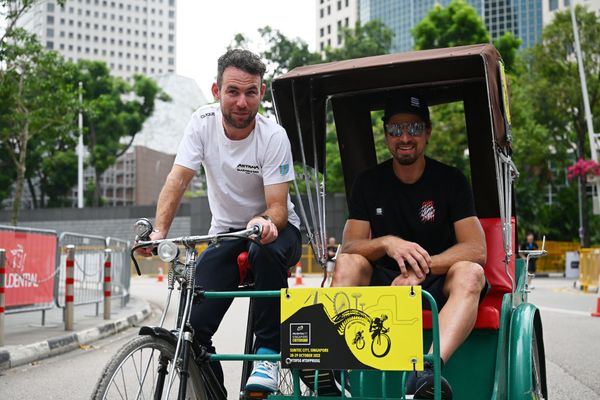
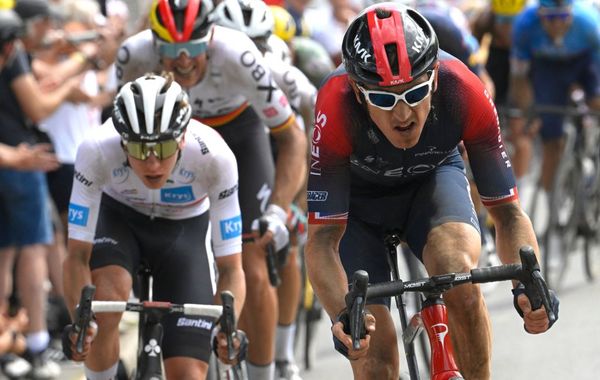
.png?w=600&auto=format)
